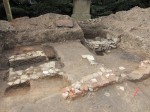 Archaeologists excavating the site of William Shakespeare’s last home, New Place, in Stratford-upon-Avon, have discovered the remains of the property’s kitchen. They have identified a fire hearth (the Tudor equivalent of an oven) and a cold pit (the fridge) and a brew house where the playwright’s staff would have made beer and preserved food by pickling and salting. They also found fragments of dishes and cups. The latest archaeological finds have made it possible to create accurate drawings of what New Place looked like in Shakespeare’s time.
Archaeologists excavating the site of William Shakespeare’s last home, New Place, in Stratford-upon-Avon, have discovered the remains of the property’s kitchen. They have identified a fire hearth (the Tudor equivalent of an oven) and a cold pit (the fridge) and a brew house where the playwright’s staff would have made beer and preserved food by pickling and salting. They also found fragments of dishes and cups. The latest archaeological finds have made it possible to create accurate drawings of what New Place looked like in Shakespeare’s time.
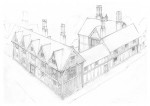 The Shakespeare Birthplace Trust has raised half the £5.25 million needed to restore and redesign the site of New Place from sources including the Heritage Lottery Fund. (Click here to help the Trust raise the second half.) The three sections of the property — Nash’s House, home of Shakespeare’s granddaughter Elizabeth and her husband Thomas Nast built adjacent to the New Place home, the Knot Garden, a sunken garden inspired by Jacobean designs installed on the grounds after World War I, and the Great Garden, a former priory garden incorporated into the New Place property in the mid-16th century — will be refurbished and reconceived as a museum and garden dedicated to Shakespeare, his life, family and works. The archaeological surveys of the site are part of this program.
The Shakespeare Birthplace Trust has raised half the £5.25 million needed to restore and redesign the site of New Place from sources including the Heritage Lottery Fund. (Click here to help the Trust raise the second half.) The three sections of the property — Nash’s House, home of Shakespeare’s granddaughter Elizabeth and her husband Thomas Nast built adjacent to the New Place home, the Knot Garden, a sunken garden inspired by Jacobean designs installed on the grounds after World War I, and the Great Garden, a former priory garden incorporated into the New Place property in the mid-16th century — will be refurbished and reconceived as a museum and garden dedicated to Shakespeare, his life, family and works. The archaeological surveys of the site are part of this program.
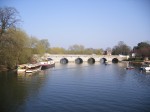 The house that would become known as New Place was originally built by Hugh Clopton, a wealthy mercer (a merchant specializing in the trade of imported luxury fabrics and dress accessories) who had made his fortune in London where he served terms as Sheriff and Lord Mayor. He was a proud native son and benefactor of Stratford-upon-Avon, rebuilding a guild chapel, replacing a rickety wooden bridge with a beautiful stone arch bridge and leaving provisions in his will for further improvements to the city along with funds to help support maidens, scholars and apprentice mercers. Even as he held important guild and municipal offices in London, in about 1483 Clopton had a new house built for himself in his hometown on Chapel Street. It was the second largest house in town.
The house that would become known as New Place was originally built by Hugh Clopton, a wealthy mercer (a merchant specializing in the trade of imported luxury fabrics and dress accessories) who had made his fortune in London where he served terms as Sheriff and Lord Mayor. He was a proud native son and benefactor of Stratford-upon-Avon, rebuilding a guild chapel, replacing a rickety wooden bridge with a beautiful stone arch bridge and leaving provisions in his will for further improvements to the city along with funds to help support maidens, scholars and apprentice mercers. Even as he held important guild and municipal offices in London, in about 1483 Clopton had a new house built for himself in his hometown on Chapel Street. It was the second largest house in town.
The property stayed in the Clopton family until the mid-16th century when it passed to the recusant Catholic Underhill family. Shakespeare purchased the house and property including gardens, two barns and an orchard, from William Underhill on May 4th, 1597, for £120 in silver. It was a grand home, with impressively wide frontage, 20 rooms and 10 fireplaces, but by the time Shakespeare bought it, the house, which had been described by antiquary John Leland sixty years earlier as a “praty house of bricke and tymbre” was in “great ruyne and decay and unrepayred.” Renovations began immediately. Shakespeare’s wife Anne seems to have moved in full-time right away; William split his time between Statford and London for a while before moving permanently into New Place in 1610. There he planted the first mulberry tree in Stratford, according to legend with his own two hands.
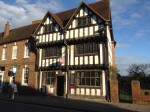 The Bard lived there until his death on April 23rd, 1616. He bequeathed the property to his daughter Susanna Hall who lived there until her death in 1649. It then went to her daughter Elizabeth. Elizabeth died in 1670. After her husband’s Thomas’ death in 1674, New Place was sold to Sir Edward Walker who in turn left it to his daughter, wife of Sir John Clopton. Thus by 1700, New Place once again belonged to the Clopton family. Sir John had it almost entirely rebuilt before 1702 for his son Hugh.
The Bard lived there until his death on April 23rd, 1616. He bequeathed the property to his daughter Susanna Hall who lived there until her death in 1649. It then went to her daughter Elizabeth. Elizabeth died in 1670. After her husband’s Thomas’ death in 1674, New Place was sold to Sir Edward Walker who in turn left it to his daughter, wife of Sir John Clopton. Thus by 1700, New Place once again belonged to the Clopton family. Sir John had it almost entirely rebuilt before 1702 for his son Hugh.
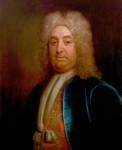 Sir Hugh Clopton took pride in the association of his family home with William Shakespeare. He opened New Place to visitors and told stories of questionable likelihood about finding epigrams scratched onto the windows by Shakespeare and his daughters (his only son, Hamnet, had died the year before they bought the house). The next owner would not be so genial.
Sir Hugh Clopton took pride in the association of his family home with William Shakespeare. He opened New Place to visitors and told stories of questionable likelihood about finding epigrams scratched onto the windows by Shakespeare and his daughters (his only son, Hamnet, had died the year before they bought the house). The next owner would not be so genial.
Reverend Francis Gastrell, a canon of Lichfield Cathedral, bought the property from the Clopton estate in 1753. He had no interest in opening his home to literary pilgrims and was sick to death of people showing up at his house expecting to get a show the way they had in Sir Hugh’s day. In 1756, he chopped down the mulberry tree that was the focus of many a literary pilgrim’s attention thanks to the story that it had been planted by the Bard himself. In 1759, he got into a dispute with the city on whether he should pay the full tax rate or get a reduced rate because he lived part of the time in Lichfield. Vowing New Place would never be assessed again, he razed it to the ground.
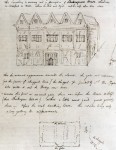 Several depictions of New Place in the 18th century survive. Engraver and antiquary George Vertue visited Stratford in 1737. He sketched New Place and took notes describing the property as a two storey, half-timbered building with an attic, five gabled bays and a central gateway facing onto Chapel Street. Scholars now believe the Vertue sketch is not of the home itself, but of a gatehouse with servants’ quarters and a long gallery. There’s also an extant print of a drawing by Samuel Winter of the main house ca. 1759.
Several depictions of New Place in the 18th century survive. Engraver and antiquary George Vertue visited Stratford in 1737. He sketched New Place and took notes describing the property as a two storey, half-timbered building with an attic, five gabled bays and a central gateway facing onto Chapel Street. Scholars now believe the Vertue sketch is not of the home itself, but of a gatehouse with servants’ quarters and a long gallery. There’s also an extant print of a drawing by Samuel Winter of the main house ca. 1759.
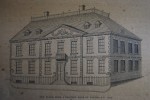 The New Place property was sold multiple times in the late 18th and 19th centuries. Parts of it were sold piecemeal and became detached from the original property. What had once been the Great Garden became the Royal Shakespearean Theatre in 1829, but it didn’t even survive 50 years. Shakespeare enthusiast J.O. Halliwell launched a fundraising campaign in 1861 to acquire the full grounds of New Place. He cleared some parts of the property of its later construction and excavated the site in 1862 and 1863, finding parts of the original 15th century home and the 18th century rebuild. In 1872 the former Royal Shakespearean Theatre was demolished. The grounds were redesigned as a pleasure garden and in 1884, the entire New Place property was transferred the Shakespeare Birthplace Trust.
The New Place property was sold multiple times in the late 18th and 19th centuries. Parts of it were sold piecemeal and became detached from the original property. What had once been the Great Garden became the Royal Shakespearean Theatre in 1829, but it didn’t even survive 50 years. Shakespeare enthusiast J.O. Halliwell launched a fundraising campaign in 1861 to acquire the full grounds of New Place. He cleared some parts of the property of its later construction and excavated the site in 1862 and 1863, finding parts of the original 15th century home and the 18th century rebuild. In 1872 the former Royal Shakespearean Theatre was demolished. The grounds were redesigned as a pleasure garden and in 1884, the entire New Place property was transferred the Shakespeare Birthplace Trust.
 Because the site is now a listed park and garden, so the Trust can’t just reconstruct the house as they think it was when Shakespeare lived there. Instead, they’ve designed an imaginative way to convey the important areas of the structure within the parameters of the garden. Brass lines in the ground will mark the footprint and key areas of the previous structures. Halliwell’s excavations will be of aid in this because he never had them backfilled which has helped archaeologists determine which part of the buildings were in which location and where else to dig to find undisturbed archaeological features. The garden will be re-landscaped with themes evoking Shakespeare.
Because the site is now a listed park and garden, so the Trust can’t just reconstruct the house as they think it was when Shakespeare lived there. Instead, they’ve designed an imaginative way to convey the important areas of the structure within the parameters of the garden. Brass lines in the ground will mark the footprint and key areas of the previous structures. Halliwell’s excavations will be of aid in this because he never had them backfilled which has helped archaeologists determine which part of the buildings were in which location and where else to dig to find undisturbed archaeological features. The garden will be re-landscaped with themes evoking Shakespeare.
The redesign was originally scheduled to be complete in time to commemorate the anniversary of William Shakespeare death in April of 2016, but the archaeological discoveries have pushed back the opening date to the summer.
[youtube=https://youtu.be/I3R1v1sPU64&w=430]
The advert was a bit much, I think, but am fascinated by the park and the house bits. I grew up a few miles from one of the USA’s better known Shakespearean theatres, in Ashland, Oregon, and spent a lot of time as a teen hanging around the back of the theatre watching back-stage goings on and being entranced by the bard’s words. Have never gotten over it, and passed it on to one of my children, who read the entire works of Shakespeare for pleasure as a teen. I’d love to go see this when it opens, though it’s unlikely I’ll get the chance. Picked up the name Hall, which appears several times in my genealogy. I considered twiddling my genealogy to make it look as if I’m descended from Shakespeare through his daughter but it’s too much work (some people go to great lengths to find imaginary links to famous people, which baffles me). I think most of my people were already in the New World by then anyway.
Wonder if there was any Falstaff in that fridge.
Fascinating. Time Team (UK) had a memorable episode devoted to New Place, but their dig didn’t find a whole lot as I recall.